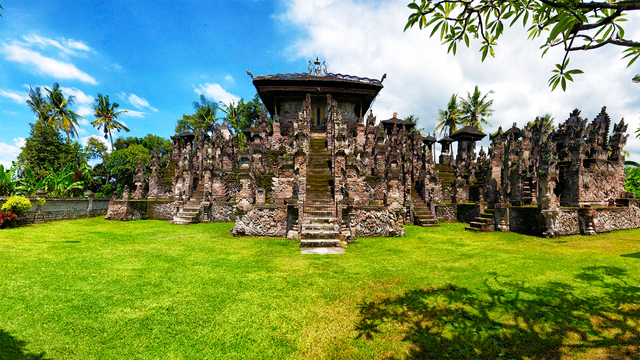On the map

The Hindu temple Pura Beji Sangsit is located in the village of Sangsit in northern Bali, approximately 8 kilometers from the city of Singaraja.
Pura Beji is dedicated to the rice goddess Devi Sri and is particularly revered by farmers. The temple's architecture is very typical of northern Bali, characterized by intricate decorations and carvings featuring leafy motifs.
The temple dates back to the 15th century, a time when Brahmins arrived in Bali from the Javanese kingdom of Majapahit. During that era, the village of Sangsit was known as Beji, which is the name given to the temple.
The Balinese word "beji" refers to a temple pond used for holy water rituals.
Due to its connection to a water source, farmers began to revere it as an agricultural temple or subak temple. Subak is the Balinese system of rice field irrigation, introduced in 1074 during the reign of Prince Marakata.
The temple has been restored several times while preserving its original style.
The temple's foundations and walls are made of white sandstone and adorned with carvings depicting leaves and grape motifs. Traces of paint found on the patterns indicate that the temple was once painted.
Statues of demons and serpent guardians, inspired by Hindu epics, adorn the stone staircases and walls.
Pura Beji, like all Balinese Hindu temples, is traditionally divided into three parts - the outer courtyard (jaba pisan or nista mandala), the middle courtyard (jaba tengah or madya mandala), and the inner courtyard (jero or utama mandala).
In the outer courtyard, there is a pavilion called kulkul with a unique wooden bell, which is used for calling people to prayer. It is less decorated compared to other temple structures, indicating that it was likely built later.
Entry into the middle courtyard is through the "split gates" of the candi bentar, covered with intricate decorations of plants and flowers in the traditional style of northern Bali. At the top, you can see several reliefs of the head of the divine being Bhoma, who is meant to protect the temple from evil spirits.
There are also several traditional Balinese pavilions called "bale" in the middle courtyard.
Entry to the inner courtyard is through a large portal called "paduraksa," decorated with images of vines and flowers. Several depictions of Bhoma's head are also located at the top of the portal.
Another interesting architectural feature of the temple is the images of two foreigners playing string instruments on either side of the serpent-like naga figure.
The main sanctuary of the temple, called "pelinggih," dedicated to Sang Hyang Widhi Wasa, is located in the inner courtyard.
In Balinese mythology, Bhoma is the son of the rain god Dewa Vishnu and the earth goddess Devi Prithvi. Once, when Vishnu in the form of his avatar, the wild boar Varahi, was digging the earth, he encountered the beautiful goddess of the earth named Devi Prithvi.
This encounter led to a union between Vishnu and Prithvi, resulting in the birth of the terrifying son Bhoma.
The story of Vishnu as a boar digging the earth to meet Prithvi symbolizes the torrents of heavy rainwater falling onto the earth.
The word "Bhoma" comes from the Sanskrit word "bhaūma," which means something that grows or is born from the earth or something connected to the earth.
You can add one right now!